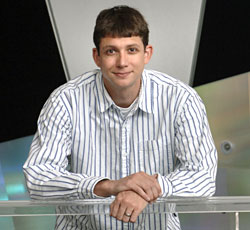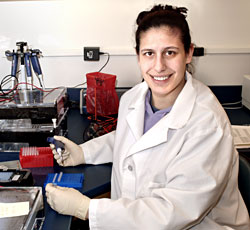Inside Iowa State
Inside ArchivesSubmit newsSend news for Inside to inside@iastate.edu, or call (515) 294-7065. See publication dates, deadlines. About InsideInside Iowa State, a newspaper for faculty and staff, is published by the Office of University Relations. |
Feb. 24, 2006 Student successUndergraduates tackle important researchby Dan Kuester While graduate students, post docs and professors often steal the research limelight, there are undergraduates involved in research all over campus. From power plants to corn plants, ISU's undergrads are involved in projects that will help them get into graduate school and find good jobs. Some are just in it for pure intellectual pursuit. In this two-part series, Inside highlights some of the work these undergraduates are doing. 
Todd Dusold Todd Chaney Dusold, senior, fine artsResearch professor: Mark Bryden My team's project:I work on a virtual engineering project for the National Energy Technology Laboratory (a series of DOE labs) to develop clean coal energy. The goal is to develop a zero-emissions coal power plant. My involvement is to design and model structures and parts in a three-dimensional application that are placed into a virtual environment. This gives researchers the ability to study the power plant in virtual reality. I jumped at this chance because:I wanted an experience that would be closer to working a real-world job. I also needed something to put on future job applications. Worth waiting for:The best part is when all the software works like it's supposed to. It will be great to see my work displayed. But there is a lot of work to do before that day comes. The perks for me:This gives me real-world experience apart from the traditional classroom. The opportunity to work on a zero-emission power plant will -- hopefully -- affect everyone's future. I hadn't thought about it:In school, it can be tough to meet with group members to complete a project. It's a whole new ball game when people are scattered across the country. 
Jennifer Scaccianoce Jennifer Scaccianoce, senior, animal scienceResearch professor: Dr. Lisa Nolan My team's project:It is commonly thought that the E. coli that makes young birds sick is different from E. coli that makes old birds sick. I work with E. coli collected from sick poultry to understand why. E. coli is one of the most prevalent pathogens found in the poultry industry. Why I make time for this:I started working in the lab to understand a different side of the veterinary field and to get a summer job in Ames. I continue to work here because I keep learning new things every day and the people are wonderful. It is a great opportunity to work with doctoral students, post docs, assistant scientists and professors all at the same time. Everyone is in a different place in his or her learning curve, but they all take time to help the people who are less knowledgeable than themselves. My best day:The lab learned that we had published two papers and received a grant, all in the same day. We as a lab were very proud of that day. Looking ahead:This experience has opened my eyes to a world of ways to use my veterinarian degree in the future. I didn't know:I have learned about cutting-edge molecular techniques. 
Kyle Schochenmaier Kyle Schochenmaier, senior, computer engineeringResearch professor: Brett Bode My team's project:We design, develop and implement software that lets users combine hard disks of many computers together and use them as if they were a single, much larger drive. Why I wanted in:I can take concepts I have learned about in classes and apply them to real-world problems that can't be addressed in a classroom situation. Also, this gives me an excellent opportunity to 'get my foot in the door' of the global consortium of software and hardware developers in my field of interest. What's in it for me:Last fall I attended a supercomputing conference in Seattle, Wash. I presented and explained some of the results of my laboratory's active research and discussed some of the further applications of it with other developers. I made countless contacts for my future in the field, and was able to actually meet some of the people I had been working with via e-mail. The downside:I'm not sure organizations understand the value of the experience a student can get through research. It may get overlooked as students try to land a co-op or internship. I never knew:In the world of high-performance computing, it is not at all uncommon to spend $2,500 on a computer, and $2,000 on the network card for it. Photos by Bob Elbert |